Coronavirus (COVID-19) Pandemic: Personal Protective Equipment Preservation Best Practices
FEMA • April 15, 2020
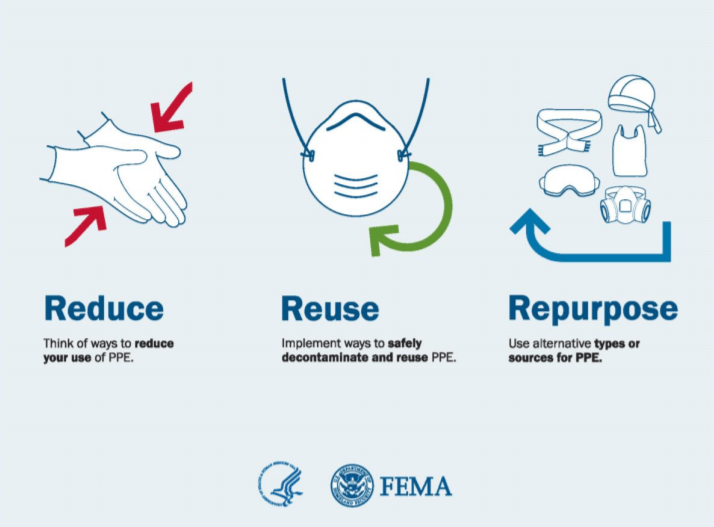
This guidance summarizes best practices for national implementation to sustain personal protective equipment (PPE) while ensuring the protection workers during the coronavirus (COVID-19) pandemic response.
Objective
The objective of the COVID-19 National Strategy for Addressing Personal Protective Equipment (PPE) Shortage is to
ensure protection against COVID-19 for healthcare workers, first responders, and patients by implementing three
pillars of practice: reduce – reuse – repurpose. Due to the COVID-19 pandemic response and associated PPE
shortages, implementation of contingency and crisis capacity plans may be necessary to ensure continued
availability of protective gear.
This fact sheet amplifies Centers for Disease Control and Prevention (CDC) strategies on conventional, contingency
and crisis capacity strategies for optimizing PPE. All U.S. healthcare facilities should begin using PPE contingency
strategies now and may need to consider crisis capacity strategies if experiencing PPE shortages.
What Do I Do and How Do I Do it?
- Reduce Usage Rate of PPE by Modifying Normal Operations and Procedures
- Limit the need for PPE by maximizing use of barrier controls whenever possible (e.g. masking patients,
- Plexiglas barriers, car windows and improved ventilation systems).
- Place IV towers and ventilators outside of patient rooms, as clinically appropriate, to enable appropriate monitoring and management without donning of PPE.
- Automate delivery of food and supplies.Use tele-consultation, internet-based interviews, or remote camera-based observation, as available.
- Limit visitor access and offer technology-enabled alternatives (e.g., video chat).
- Understand PPE requirements and burn-rates - cdc.gov/coronavirus/2019-ncov/hcp/ppe- strategy/burncalculator.html
- Consider extending use-times of undamaged, non-visibly soiled PPE beyond single patient contact and other standard practice durations.
- Note: OSHA has relaxed enforcement of annual fit-testing requirements for N-95 filtering facepiece respirators (FFRs) - osha.gov/news/newsreleases/national/03142020.
- Reuse PPE by Implementing Optimization, Decontamination, and Reuse Procedures
- Implement strategies to optimize supplies and equipment: cdc.gov/coronavirus/2019- ncov/hcp/ppestrategy/index.html
- Implement expanded facility-based PPE reuse policies and procedures.
- Track “check in” and “check out” of PPE designated for reuse. Each worker is provided specific PPE at the beginning of the shift. At the end of the shift, all PPE is labeled, collected, and stored forreuse (which may entail appropriate decontamination using devices with issued Food and Drug Administration (FDA) Emergency Use Authorization (EUA).
- Implement guidance for decontamination and reuse of FFRs:
- cdc.gov/coronavirus/2019-ncov/hcp/ppe-strategy/decontamination-reuse-respirators.html
- osha.gov/memos/2020-04-03/enforcement-guidance-respiratory-protection-and-n95- shortagedue-coronavirus
- For large-scale decontamination of N-95 FFRs consider using the following methods:
- Industrial or facility-based vaporized hydrogen peroxide sterilization systems: fda.gov/media/136529/download
- Industrial or facility-based moist heat disinfection systems (NOT autoclaves)
- Facility-based ultraviolet germicidal irradiation (UVGI) systems
- For low-volume or personal decontamination of N-95 FFRs consider using commercially available microwavable moist heat disinfection devices following manufacturer’s instructions (e.g. do not put metal parts in microwaves).
- Repurpose Alternative Types or Sources of PPE
- Use alternative NIOSH-approved respirators in lieu of N-95 FFR for activities for which respiratory protection is required. See fda.gov/media/135763/download. Examples include:
- powered, air-purifying respirators (PAPRs);
- reusable air-purifying respirators (elastomeric half and full facepiece respirators);
- other disposable air-purifying particulate FFRs.
- Contingency - Seek alternative supplies of PPE.
- Encourage community members to donate private stocks of unused/unopened surgical masks, gloves, gowns, and N-95 respirators to your facility.
- Seek PPE and other equipment from dentist offices, veterinarians, individuals, and other sources, including business that are not active.
- Use commercial sources of industrial Tyvek coveralls, face shields, goggles, shoe covers, etc.
- Crisis - Use N-95 FFRs beyond their expirations dates if certain conditions are met
- Crisis - Use FDA authorized imported, non-NIOSH-approved disposable FFRs.
Implementation
Organizations need to assemble a team to carefully review existing Health and Safety Plan (HASP) and Respiratory
Protection Plan (RPP) policies and procedures for opportunities to reduce, reuse, or repurpose and should develop
contingency and crisis operational plans. Such a team might include (where available) environmental health officers,
safety officers, industrial hygienists, logistics officers, infection prevention practitioners, operations chiefs, medical
officers, and work-force representatives.
To ensure uniform application of modified practices, processes and procedures, and, concurrently, the safety of
workers, all workers must be trained in the plans, with recommended elements of such training including:
- The rationale for changes, contingency and crisis standards during COVID-19 related PPEshortages
- New PPE guidance (FDA, CDC, DOJ) related to COVID-19
- Proper methods to conduct new or changed work practices (e.g., staffing, social distancing)
- Methods to install or utilize any barrier controls (e.g. patient masking, Plexiglas shields)
- Proper donning and doffing of PPE to minimize self-infection
- Proper hand hygiene
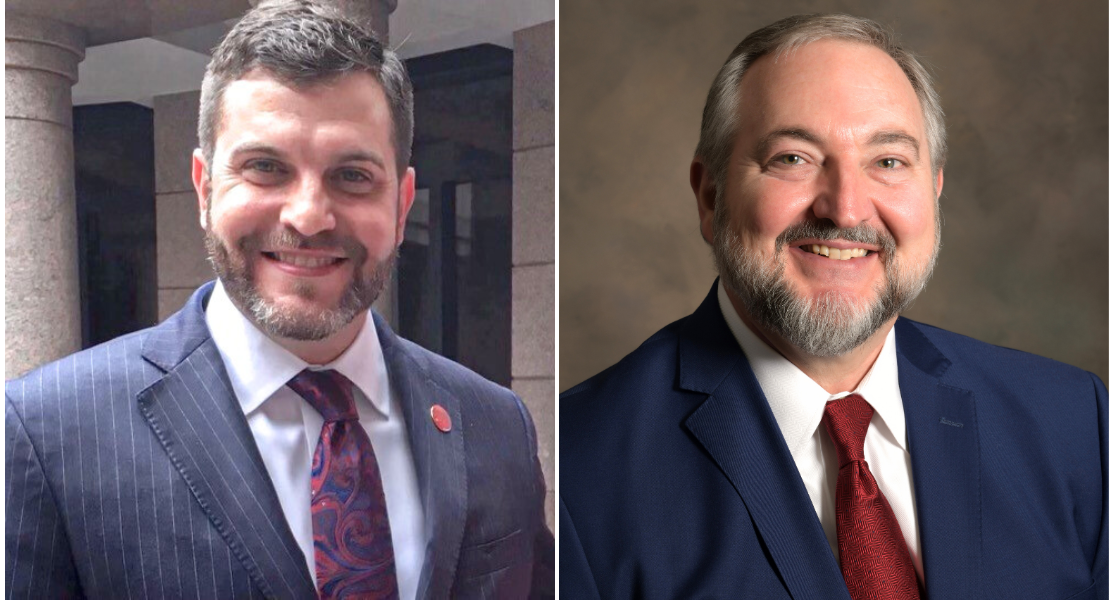
ETCOG is pleased to announce new leadership for its Chief Elected Officials – Rural Transportation Planning Organization (CEO–RTPO) Board. At its December 4 th meeting, the CEO–RTPO Board reappointed Marion County Judge Leward LaFleur as Chair and Camp County Judge AJ Mason as Vice Chair, and reappointed its Executive Committee members. The CEO–RTPO Board consists of the county judges from each of the 14 counties served by ETCOG, the Mayors of Longview and Tyler, the three Texas Department of Transportation District Engineers serving the ETCOG region, and the Executive Director of the North East Texas Regional Mobility Authority. The Board serves a dual function of shared oversight of the region's workforce programs with the Workforce Solutions East Texas Board and working directly with TXDOT to ensure that transportation priorities are developed and solutions implemented for the region's rural communities. "With deep admiration and respect for my colleagues, I express my sincere appreciation for their confidence in calling me to continue to serve as Chairman of the Chief Elected Officials –Rural Transportation Planning Organization Board. I have such esteem for these county judicial and city leaders, who sacrificially serve the needs and interests of East Texas. Together, as servants of the public's trust, we will continue to confront challenges and seize opportunities for the future of the 14 counties and cities in our region. With rich natural resources, the beauty of our lands, coupled with the values and strong work ethic of our people, East Texas sits in a strategic position to grow economically while maintaining the quality of life we all enjoy. As a son of Gregg County, God called me back to my East Texas roots after my service to our country through the U.S. Navy. Upon returning home to the piney woods, I had a burden in my heart to invest my life in serving my fellow East Texans. As I do that, I ask for the prayers of my colleagues and the people of East Texas," said Marion County Judge Leward LaFleur. Judge LaFleur joined the board in 2018, has served on its Executive Committee since 2021, and began his chairmanship in 2023. “Heartfelt congratulations to Chairman LaFleur on his re-election to lead the CEO-RTPO Board once again!! His leadership and dedication to the East Texas region are appreciated by his fellow County Judges and Mayors, who once again supported his candidacy, and by the entire East Texas Council of Governments staff!” said ETCOG Executive Director David Cleveland. Judge AJ Mason joined the board in 2016 and has served as its Vice Chair and on the Executive Committee since 2018. "Continuing to work with the other members of the CEO-RTPO board presents a great opportunity to serve our region as a whole. Bringing that knowledge and information back to Camp County is beneficial to the citizens I represent. Under Judge LaFleur's chairmanship, our region will continue to face new challenges in a productive way that will benefit all East Texans," said Camp County Judge AJ Mason. The board also reappointed its Executive Committee, which may meet on behalf of the full board as needed between regularly scheduled meetings. It is comprised of Chair LaFleur, Vice Chair Mason, Rusk County Judge Joel Hale, Cherokee County Judge Chris Davis, and Harrison County Judge Chad Sims. Under the Workforce Innovation & Opportunity Act, the CEO Board is responsible for the leadership and board appointments to the local workforce development board. The CEOs partner with the Workforce Solutions East Texas Board to build a premier workforce in the region and are the primary source of local workforce policy. ETCOG formed its RTPO in 2009 to provide a forum for local elected officials to establish rural transportation project priorities and planning, and provide direct input to TxDOT concerning those priorities for areas not included in a Metropolitan Planning Organization (MPO). Through the RTPO, all 14 of our counties and the cities not served by the Longview or Tyler MPOs can deliver a unified message to state and federal decision-makers on transportation needs and priorities. The Board meets during April, August, and December to address the joint business agenda of the CEO–RTPO Board in a blended meeting format. The full membership of the CEO–RTPO Board is available at www.etcog.org/about#GoverningBoards .

ETCOG welcomed about 60 guests last month for the ribbon-cutting of the new GoBus Maintenance Facility, located behind ETCOG Headquarters in Kilgore. The event marked the completion of a project that has been in discussion, planning, and construction for several years, bringing together local leaders, partner agencies, and community members to see the results firsthand. ETCOG's Executive Director, David Cleveland, opened the program by recognizing elected officials and partners who helped move the project forward. He noted that the new facility strengthens ETCOG's mission to support the needs of East Texans through dependable public transit and thanked the teams and contractors who worked hard to bring the building to life. Transportation Director Vince Huerta shared how the facility will improve daily operations for GoBus across the 14-county region. With added work bays, a wash bay, training space, and expanded parking, maintenance can be handled on-site, giving crews the tools they need to keep vehicles safe and ready for the road. TxDOT's Greg Davis spoke about how the $3.3M project showcased the value of strong cooperation between state and regional partners. ETCOG 1st Vice Chairman, Camp County Judge A.J. Mason, reflected on his experience reviewing the project from its earliest financial discussions to its completion. "When this project was first discussed, it was an idea on paper," he said. "Standing here today, it's rewarding to see those decisions become bricks and mortar...a place that will keep GoBus running safely for years to come." After the ribbon was cut, attendees toured the facility and shared conversations about the years of planning that led to this point. It was a moment that honored the work behind the scenes and the steady commitment to serving the region well.

Homeland Security and Criminal Justice Grant Funding Available for East Texas Public Safety Projects
East Texas public agencies, nonprofits, schools, and federally recognized tribes will soon have the chance to apply for FY 2027 grant funding through the Office of the Governor’s Public Safety Office. The application window for Homeland Security and Criminal Justice programs opens Monday, December 15, 2025, and closes Thursday, February 13, 2026. ETCOG invites new and returning applicants from our fourteen-county region to attend free grant workshops hosted by our Public Safety team. Grant funding will be available for the following programs: Homeland Security State Homeland Security Program – Regular Projects (SHSP-R) Law Enforcement Terrorism Prevention Activities (LETPA) Criminal Justice General Victim Assistance Direct Services Program (VOCA) Violence Against Women Justice and Training Program (VAWA) Juvenile Justice & Truancy Prevention Grant Program (JJ/TP) Criminal Justice Program (JAG) Weekly workshops for each grant category will be held online from December 20 through January 28, 2026. Participation is required for all applicants for each grant category. To join a Homeland Security workshop, visit www.pineywoods911.com/homeland-security . Sessions are held on Wednesdays from 10 to 11:15 AM on these dates: December 31, 2025 January 7, 2026 January 14, 2026 January 21, 2026 January 28, 2026 To join a Criminal Justice workshop, visit www.pineywoods911.com/criminal-justice . Sessions are held on Tuesdays from 10 to 11:15 AM on these dates: December 30, 2025 January 6, 2026 January 13, 2026 January 20, 2026 “The goal is to improve public safety, support victims of crime, and help jurisdictions address gaps in the region with funding that encourages practical solutions,” said ETCOG Public Safety Director Stephanie Heffner. “We guide applicants on what to include in their proposals and what they need to track once funding is awarded, so we can keep bringing strong public safety projects to East Texas.”

ETCOG announces that $3.1 million in grants from the Office of the Governor's (OOG) Public Safety Office have been awarded to East Texas jurisdictions and nonprofit organizations. These funds are aimed at enhancing public safety and supporting victims of crime. The program’s mission is to strengthen Texas communities by supporting initiatives that help victims recover and feel secure while also preventing crime through programs that: Prevent juvenile delinquency and support truancy prevention Provide services to victims of crime and address violence against women Support law enforcement and improve the criminal justice system Prevent child sex trafficking, bring justice to its perpetrators, and restore victims ETCOG's Public Safety Division assists jurisdictions in applying for these funds annually, and applications submitted for funding are ranked and scored by the ETCOG Criminal Justice Advisory Committee, which is comprised of local subject-matter experts from across the region. The following Victims of Crime Act, Justice Assistance, Violence Against Women Act, and Juvenile Assistance grants totaling $3,136,019.36 have been approved by the OOG for funding in East Texas: Victims of Crime Act Funds - $2,528,962.18 The Crime Victims Assistance Grant Program (VOCA) devotes resources to providing direct services to victims of crime to help them recover and navigate the justice system.
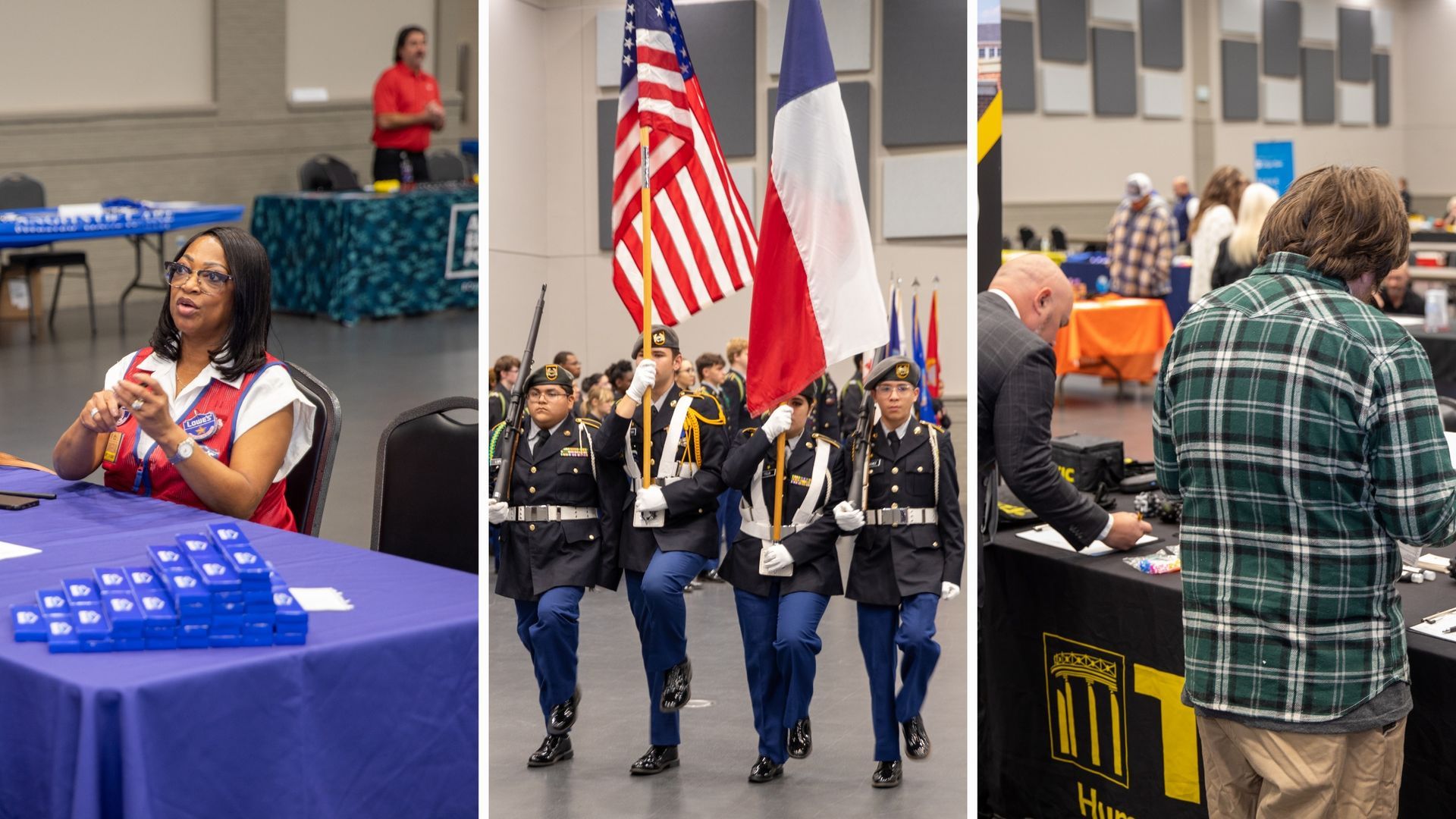
On Wednesday, November 5, Workforce Solutions East Texas hosted the region’s largest hiring event of the year at the Maude Cobb Convention Center in Longview, as part of the Texas Workforce Commission’s 14th annual Hiring Red, White & You! statewide initiative. The event honored veterans with an opening ceremony at 9:30 a.m., followed by a job fair from 10:00 a.m. to 1:00 p.m. open to the public. More than 65 employers participated, offering opportunities for veterans, transitioning service members, military spouses, and other job seekers. Among the exhibitors, ETCOG hosted a booth to recruit new drivers for the GoBus public transit program. “East Texas is blessed to have so many vets to call our neighbors,” said Doug Shryock, Lt. Col. USAF (Ret.), Executive Director of Workforce Solutions East Texas. “Knowledge, skills, and abilities—hard-won across the country and around the world—make our communities stronger and more vibrant. Our employers need these valuable resources.” This year’s event was part of a statewide effort to support veterans in their transition to civilian careers. Since its launch in 2012, Hiring Red, White & You! has connected over 153,000 job seekers, including 52,000 veterans, with more than 26,000 employers across Texas. “ It’s important that we continue to serve those who served, and do so with priority, resources, and commitment,” said TWC Chairman Joe Esparza. “Hiring Red, White & You! events make a difference in the lives of veterans across Texas.” Event Highlights: Total job seekers served: 438 Employers represented: 69 Workforce Solutions East Texas and ETCOG thank all participants, employers, and partners who made this event a success. Together, we continue to build a stronger workforce and honor the contributions of our veterans.
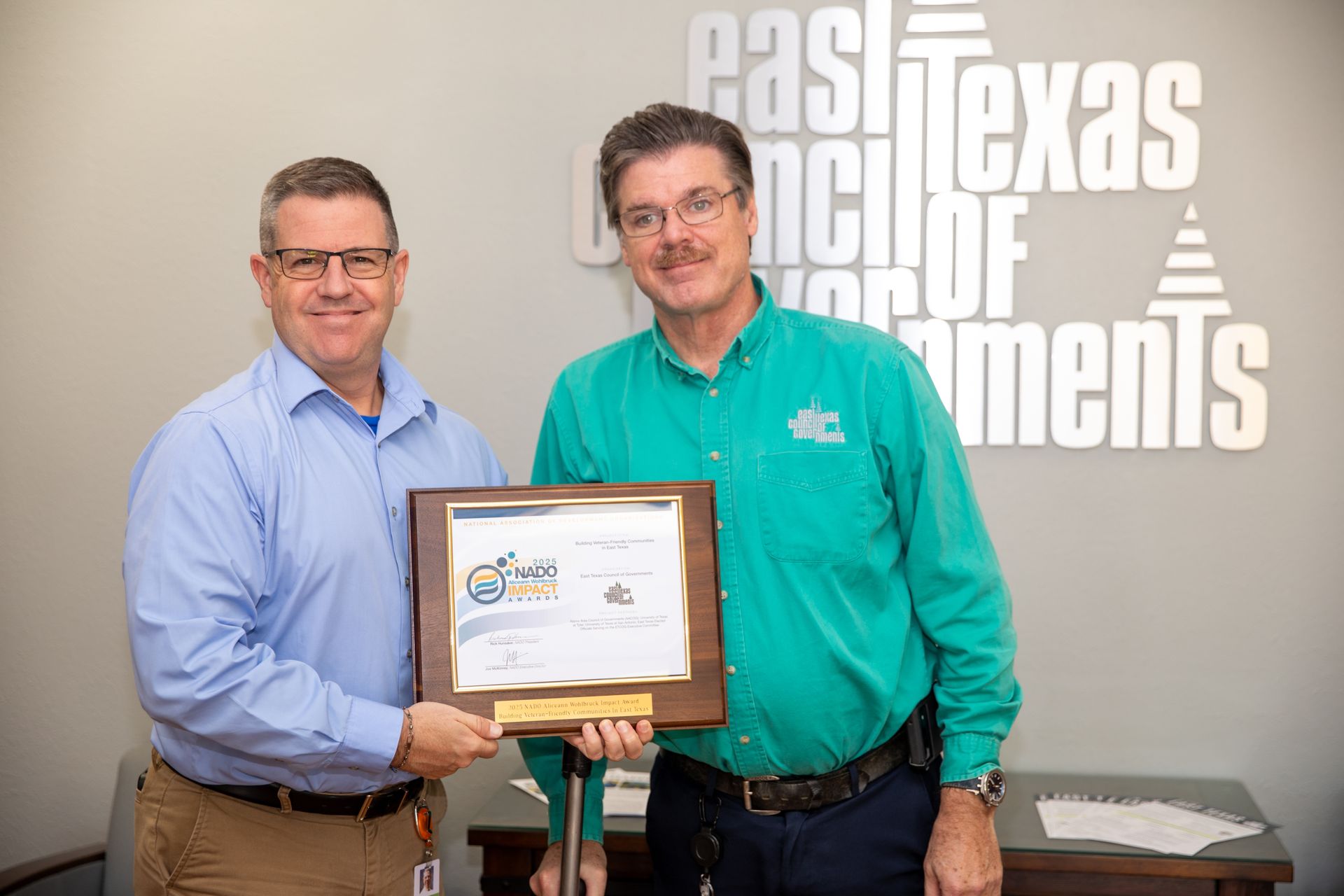
ETCOG has received a 2025 Aliceann Wohlbruck Impact Award from the National Association of Development Organizations (NADO) for its efforts in building Veteran-Friendly Communities in East Texas. The Veteran-Friendly Community Designation Program launched in 2024 as a collaborative effort between ETCOG, the Alamo Area Council of Governments (AACOG), the University of Texas at Tyler (UTT), and the University of Texas at San Antonio (UTSA). This program formally recognizes communities that show strong, lasting support for military veterans through policies, services, and community involvement. It requires each participating city or county to provide a comprehensive community profile, develop a plan focused on veterans, and commit to an annual self-assessment to maintain the designation. Tyler/Smith County and Quitman/Wood County were the first to receive the designation and have become a model for supporting veterans in areas such as housing, employment, healthcare, and education. Presented annually, the NADO Impact Awards honor regional development organizations and their partners for strengthening communities, building regional resilience, and enhancing local economies through innovative approaches to economic and community development. NADO is a Washington, DC-based membership association of regional development organizations that promotes programs and policies that strengthen local governments, communities, and economies. This year’s cohort included 90 impactful projects led by 79 organizations across 24 states. These award-winning efforts were recognized during NADO’s 2025 Annual Training Conference, held this past October in Salt Lake City, Utah. All selected projects are featured in an interactive StoryMap that showcases summaries, images, and key partners. The map is available at www.nado.org/2025impactawards/ . “The Impact Awards are an annual reminder of the creativity and commitment that regional development organizations bring to their communities,” said 2024-2025 NADO President Rick Hunsaker, Executive Director of the Region XII Council of Governments in Iowa. “This year’s awardees show how local and regional partnerships, driven by vision and collaboration, can lead to lasting positive change across our country.” “We’re proud to be recognized by NADO for a program that recognizes the men and women who lay their lives on the line to keep us free!” said David Cleveland, Executive Director of ETCOG. “In East Texas, we believe in taking care of our veterans—not just with words, but with our actions. The Veteran-Friendly Community Designation Program demonstrates that when communities come together with a clear purpose, we can build something that truly makes a difference. We hope this program becomes a blueprint for how regions can support and encourage those who served all of us.” The Impact Awards are presented in memory of Aliceann Wohlbruck, NADO’s first executive director, who was a lifelong advocate for regional solutions and rural economic development.

Communities across East Texas are invited to apply for ETCOG’s 2025 Veteran-Friendly Community Designation. The program highlights local cities and counties that make an exceptional effort to honor and assist veterans and their families. In its first year, two East Texas communities, Quitman/Wood County and Tyler/Smith County, earned the designation. The initiative has already drawn national attention, earning ETCOG the Achievement Award from the National Association of Regional Councils and the Impact Award from the National Association of Development Organizations. “Communities that invest in their veterans strengthen the entire region,” said ETCOG Executive Director David Cleveland. “This designation shows a shared commitment to welcoming service members home and helping them thrive.” Applications are open through Thursday, December 19, 2025, at 5:00 p.m. ETCOG staff are available to help with the process, and all eligible cities are encouraged to apply. For details and application materials, visit www.etcog.org/veteran-friendly-community .

In September, Whitehouse Mayor and ETCOG Board Chairman, James Wansley, took the Oath of Office to serve as vice president of the Texas Association of Regional Councils (TARC) Board, the statewide association of regional councils, whose members are focused on enhancing the quality of life through regional strategies, partnerships, and solutions. Wansley serves on the board as a representative of ETCOG. The TARC Board elected Mayor Wansley to serve as its vice president for 2025-2026 during its annual Board of Directors meeting held in Austin last month. "It is my honor to represent ETCOG on the Texas Association of Regional Councils (TARC) board," said Wansley. "Each of TARC's 24-member Councils of Governments operates independently. During our TARC sessions, we come together to explore what's new, what works, and what needs to be improved. As vice-president of the TARC board, I look forward to learning more about successful processes and programs from other Councils of Governments and how they might help ETCOG fill service and funding gaps in our region." Mayor Wansley took office as Whitehouse Mayor in 2020 and has served as a member of the ETCOG Board of Directors and Executive Committee since 2022. He became Chairman of the ETCOG Board and Executive Committee Chairman on October 1, 2025. “Mayor Wansley is always willing to serve wherever he can, and wherever he serves, he makes a difference!” said ETCOG Executive Director David Cleveland. “In his new role as TARC Vice President, I am absolutely certain he will be an effective ambassador for identifying and implementing regional solutions to the challenges we face, both in East Texas and throughout the State!”
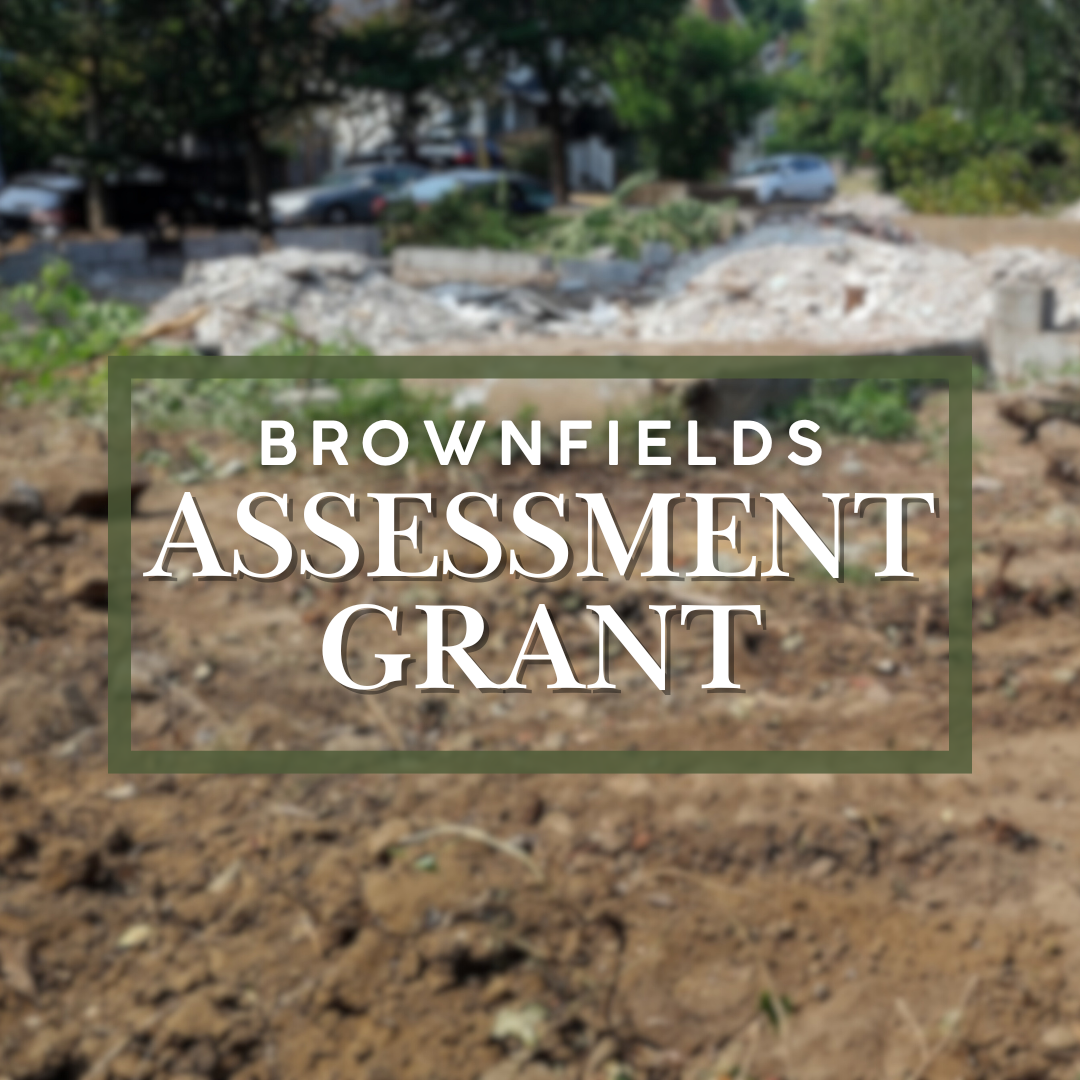
Empty buildings and unused lots can weigh a community down, but they also hold potential. ETCOG’s Brownfield Site Reuse & Revitalization Program offers funding through a $1 million EPA Brownfield Assessment Grant to help East Texas communities turn those properties into productive spaces again. What is a Brownfield? Brownfield – 1. real property, the expansion, redevelopment, or reuse of which may be complicated by the presence or potential presence of a hazardous substance, pollutant, or contaminant. 2. abandoned or underutilized property that is not being redeveloped because of fears that it may be contaminated with hazardous substances. The grant covers environmental site assessments, cleanup and reuse planning, and surveys for regulated building materials—all at no cost to cities, counties, or property owners. Whether you’re envisioning new housing, business development, or community gathering places, this program can help bring those ideas to life. Funding is available through September 2027, and ETCOG staff are available to guide applicants every step of the way. To nominate a property or learn more, visit www.etcog.org/brownfields-program .

